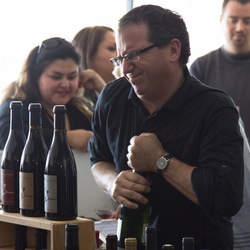10 Essential Facts on Riesling
Joh. Jos. Prüm
Wehlener Sonnenuhr Spätlese Riesling 2008
First off, delicious. And nothing can cruise through all of the courses, from Thai squid to duck salad to steak, like a Riesljng with acid and some sugar. But the alcohol....7.5% the sheer pleasure of drinking and refilling and drinking a yummy wine without monitoring one's consumption. Bliss. — 10 years ago
Pikes Wines
Traditionale Dry Clare Valley Riesling 2014
A straw coloured nectar. Floral aromas with mouth filling peach, mango and lemon grass flavours elegantly balanced with acidity. — 9 years ago
Nikolaihof
Vinothek Wachau Riesling 1997
So weird. Like liquid smoke, and poached asian pear. Like elderflower liqueur bombed in diesel. How the hell is this delicious? I don't know, but it was. I can't imagine it progressing in complexity, due to it's very nature, but I was definitely intrigued. It's like a viewing of Koyaanisqatsi. I'm not quite sure why I like it, but I did. And now I'm changed, but cannot say why. Quite confusing, but obviously unique. This is a wine drinking experience that has to be had to understand. Just wow... — 9 years ago
Trimbach
Cuvée Frédéric Emile Alsace Riesling 2007
Delicate and beautiful. Faint petrol and fruit on the nose. Palate further showed the finesse of this bottle. You have to pay attention to this guy. The acid can easy overtake the fruit if your drinking passively. Drank as part of Alsace tasting with Rillettes du canard. The dryness paired perfect with the richness of the food. This was the star of the show. This will be kicking and improving for a long time. — 10 years ago
Teutonic Wine Company
Medici Vineyard Riesling 2014
Stupid good single-site Riesling from the Chehalem Mountains. Impeccable balance. Could totally see calling this as a high-quality Nahe kabinett if blinded on it but at the same time it still has a distinctly Oregonian aura about it. Nose of ripe nectarine, key lime, and honeydew, pure, slate-y wet stone minerality, cherry blossom, subtle cardamom and nutmeg spice, and just a touch of petrol starting to show. Palate echoes the nose, channeled through bracing high acid and an extra layer of flinty mineral focus. Moderate concentration, medium (-) body but with great texture from neutral oak fermentation and elevage and possibly some lees influence as well. As referenced above, sweetness is comparable to some of the less sweet German kabinett wines; delightfully off-dry. Deliciously quenching. Gonna hoard a couple bottles of this because I'd love to see how this fares with a bit more development in bottle. — 9 years ago
Tatomer
Vandenberg Riesling 2014
The rumors are true. California can make a real Riesling. The weight and texture are exquisite. Heavy and silky, the stone fruit and minerality are equally matched on the palate. Made with higher amount of botrytis but you wouldn't guess with how dry it finishes. Touches of petrol, honey, bee pollen, yellow/white flowers after a cold morning rain. Cheers to Tatomer!! — 9 years ago









Matt Perlman
Wet stone and mushroom nose. Off-dry apricot slate action on the palate. Balanced. We slammed this one right quick — 8 years ago